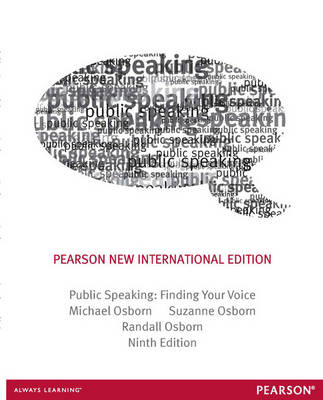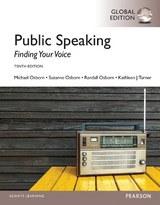
Public Speaking Pearson New International Edition, plus MyCommunicationLab without eText
Pearson Education Limited
978-1-4479-6859-7 (ISBN)
- Titel erscheint in neuer Auflage
- Artikel merken
The "Finding Your Voice" sub-title focuses a theme that has been implicit in the book from its first edition: Helping students develop as speakers and as people, as they gain presentation skills and confidence, discover causes that interest and engage them, and give them a sense of purpose or mission. This theme reinforces the book's primary goal of helping students to become better communicators in their classrooms, workplaces and communities.
Chapter 1: Finding Your Voice
What Public Speaking Has to Offer
Practical Benefits
Personal Growth Benefits
Introduction to Communication
What This Course Asks of You
Respect for the Integrity of Ideas and Information
A Concern for Consequences
Final Reflections: The Fate of Public Discourse
Chapter 2: Managing Your Fear of Speaking
Understanding Communication Anxiety
Managing Communication Anxiety
Reality Testing
Selective Relaxation
Attitude Adjustments
Cognitive Restructuring
Visualization
Putting it all Together
Final Reflections: Victory Over Fear
Chapter 3: Your First Speech: An Overview of Speech Preparation
Managing the Impressions You Make
Competence
Integrity
Goodwill
Dynamism
Planning Your First Speech
Step 1: Find the Right Topic
Step 2: Focus Your Topic
Step 3: Find Material for Your Speech
Step 4: Design Your Speech
Step 5: Outline Your Speech
Step 6: Practice Your Presentation
Step 7: Make Your Presentation
Introducing Yourself or a Classmate: An Application
Final Reflections: Exploration Through Preparation
Chapter 4: Becoming a Better Listener
The Benefits of Effective Listening
Listening in the Workplace
Listening in the Classroom
The Process of Listening
Threshold Listening
Critical Listening
Empathic Listening
Constructive Listening
Effective Listening Behaviors
Overcoming External Barriers
Overcoming Internal Barriers
Becoming a Critical Listener
Do Speakers Support Their Claims?
Do Speakers Rely on Credible Sources?
Do Speakers Use Words to Reveal or Befuddle?
What Strategies Do Speakers Use?
Evaluating Classroom Speeches
You as a Constructive Listener
You as a Critical Listener
Ethical Responsibilities of a Listener
Final Reflections: The Golden Rule of Listening
Part Two: Preparation for Public Speaking
Chapter 5: Adapting to Your Audience and Situation
Why Audience Analysis is Important
Understanding Audience Demographics
Age
Gender
Educational Level
Group Affiliations
Understanding Audience Dynamics
Attitudes, Beliefs and Values
Gathering Information about Attitudes
Motivation
Meeting the Challenges of Audiences Diversity
Apply Universal Values
Use Speaking Resources Skillfully
Avoid Language Pitfalls
Avoid Rhetorical Land Mines
Adjusting to the Communication Situation
Time
Place
Occasion
Size of Audience
Context
Final Reflections: Keeping Your Audience in Mind
Chapter 6: Developing Your Topic
What is a Good Topic?
A Good Topic Helps You Find Your Voice
A Good Topic Involves Your Listeners
A Good Topic Is One You Can Manage
Discovering Your Topic Area
Brainstorming
Interest Charts
Media Prompts
Exploring Your Topic Area
Mind Mapping
Topic Analysis
Selecting Your Topic
Refining Your Topic
General Purpose
Specific Purpose
Thesis Statement
An Overview of the Topic Selection Process
Final Reflections: The Great Chain of Communication
Chapter 7: Building Responsible Knowledge
Developing a Research Strategy
Prepare an Overview
Build a Bibliography
Acquire In-Depth Knowledge
Be Sure Your Information is Up-to-Date
Include Local Applications
Acquiring Responsible Knowledge
Drawing on Personal Knowledge and Experience
Doing Research in the Library
Doing Research on the Internet
Evaluating Research Materials
Evaluating Material from Library Resources
Evaluating Material from the Internet
Interviewing for Information
Establish Contact
Prepare for the Interview
Conduct the Interview
Record What You Learn
Taking Notes on Your Research
Preparing Source and Information Cards
Taking Notes on Your Computer
Know What Information to Record
Final Reflections: Your Substantive Voice
Chapter 8: Supporting Your Ideas
Facts and Statistics
Framing Facts
Developing Statistics
Constructing Facts and Figures
Testing Facts and Figures
Testimony
Framing Expert Testimony
Developing Lay Testimony
Constructing Prestige Testimony
Designing Testimony: Other Considerations
Examples
Types of Examples
Fashioning Powerful Examples
Testing Your Examples
Narratives
Types of Narratives
Building Narratives
Testing Your Story
Selecting and Combining Supporting Materials
Final Reflections: Developing a Strong Voice
Chapter 9: Structuring and Outlining Your Speech
Principles of a Well-Structured Speech
Simplicity
Order
Balance
Structuring the Body of Your Speech
Selecting Your Main Points
Arranging Your Main Points
Developing Your Main Points
Developing a Working Outline
Adding Transitions
Introducing and Concluding Your Speech
Introducing Your Speech
Concluding Your Speech
Selecting and Using Introductory and Concluding Techniques
Preparing Your Formal Outline
Final Reflections: Value of the Twin Disciplines
Part Three: Developing Presentation Skills
Chapter 10: Developing Presentation Aids
The Advantages and Disadvantages of Presentation Aids
Advantages of Presentation Aids
Disadvantages of Presentation Aids
Types of Presentation Aids
People
Objects and Models
Graphics
Pictures
Presentation Media
Traditional Media
New Media
Preparing Presentation Aids
Principles of Design
Principles of Color
Making Presentation Aids
Using Presentation Aids
Ethical Considerations for Using Presentation Aids
Final Reflections: Amplifying Your Voice
Chapter 11: Putting Words to Work
What Words Can Do
What Makes the Spoken Word Special
Shaping Perceptions
Arousing Feelings
Bringing Listeners Together
Prompting Listeners to Take Action
Celebrating Shared Values
The Six C's of Language Use
Clarity
Color
Concreteness
Correctness
Conciseness
Cultural Sensitivity
Magnifying the Power of Language
Using Figurative Language
Changing the Order of Words
Using the Sounds of Words to Reinforce Their Sense
Final Reflections: Give Me the Right Word
Chapter 12: Presenting Your Speech
The Power of Presentation
Developing Your Physical Voice
Pitch
Rate
Loudness
Variety
Vocal Problems
Developing Your Body Language
Facial Expression and Eye Contact
Movement and Gestures
Personal Appearance
Developing Versatility in Presentation
Impromptu Speaking
Memorized Text Presentation
Reading from a Manuscript
Extemporaneous Speaking
Developing Flexibility in Special Situations
Handling Questions and Answers
Making Video Presentations
Practicing for Presentation
Final Reflections: Taking the Stage
Part Four: Types of Public Speaking
Ch 13: Informative Speaking
Informative Speaking: An Orientation
Forms of Informative Speeches
Speeches of Description
Speeches of Demonstration
Speeches of Explanation
Helping Listeners Learn
Motivating Audiences to Listen
Maintaining Audience Attention
Promoting Audience Retention
Speech Designs
Categorical Design
Comparative Design
Spatial Design
Sequential Design
Chronological Design
Causation Design
Rising to the Challenge of the Informative Speech
Briefings: An Application
Final Reflections: The Informed Voice
Chapter 14: Persuasive Speaking
The Nature of Persuasive Speaking
The Types of Persuasive Speaking
Speeches That Focus on Facts
Speeches That Address Attitudes, Beliefs, and Values
Speeches That Advocate Action
The Persuasive Process
Awareness
Understanding
Agreement
Enactment
Integration
The Challenges of Persuasive Speaking
Enticing a Reluctant Audience to Listen
Removing Barriers to Commitment
Moving from Attitude to Action
The Challenge of Ethical Persuasion
Designs for Persuasive Speeches
Problem-Solution Design
Motivated Sequence Design
Refutative Design
Design Combinations
Final Reflections: The Case for Persuasion
Chapter 15: Building Sound Arguments
Reasoned Persuasion
Building Evidence
Developing Proofs
The Master Form of Proof
Definitions of Central Concepts
Reasoning from Principle
Reasoning from Reality
Reasoning from Parallel Cases
Avoiding Defective Persuasion
Defective Evidence
Defective Proof
Defective Patterns of Reasoning
Fallacies Related to Particular Design
Final Reflections: Persuasion That Has Legs
Chapter 16: Ceremonial Speaking
Techniques of Ceremonial Speaking
Identification
Magnification
Types of Ceremonial Speeches
The Speech of Tribute
The Acceptance Speech
The Speech of Introduction
The Speech of Inspiration
The After-Dinner Speech
Master of Ceremonies
Narrative Design
Prologue
Plot
Epilogue
Final Reflections: And in Conclusion Let Us Say
Appendix A: Communicating in Small Groups
Appendix B: Speeches for Analysis
Endnotes
Index
| Verlagsort | Harlow |
|---|---|
| Sprache | englisch |
| Maße | 215 x 275 mm |
| Gewicht | 924 g |
| Themenwelt | Kunst / Musik / Theater ► Theater / Ballett |
| Sachbuch/Ratgeber ► Sport ► Tanzen / Tanzsport | |
| Schulbuch / Wörterbuch | |
| ISBN-10 | 1-4479-6859-X / 144796859X |
| ISBN-13 | 978-1-4479-6859-7 / 9781447968597 |
| Zustand | Neuware |
| Informationen gemäß Produktsicherheitsverordnung (GPSR) | |
| Haben Sie eine Frage zum Produkt? |
